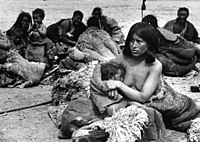Lokbar
The Lokbar is a long coat made of sheepskin or goatskin , typical of the nomads of Tibet , which is worn with the hair side inwards. The particularly cold and weather resistant garment corresponds to the extreme weather conditions of the Himalayan region .
The coat is closed with a belt, women wear it floor-length, men up to their knees. The long sleeves are cut wide, they hang about 20 to 25 centimeters over the hands and can therefore be used like gloves. The Lokbar is extremely heavy. A man's coat consists of ten tanned sheep or goat skins of adult animals and weighs around nine to ten kilograms, a Lokbar for a seven-year-old child around two three quarters to three and a half kilograms. The greasy leather and the long, very matted hair of the races living there make the coats impermeable to water. The cut is similar to the shuba made of wool or sheepskin, the traditional main item of clothing for Tibetans.
- At the Golok (Eastern Tibet), 1938
Cut hair. On the right a man with a locomotive bar trimmed with leopard skin
The lower edge of the Lokbar can be covered with otter, gazelle or other pelts for better-off personalities . Around the year 2000 otter skins were offered in Chinese markets, which were also kept ready for this purpose.
For the German Heinrich Harrer , who lives in the Tibetan capital Lhasa , around 1950 60 lambskins were used instead of sheepskins for a floor-length coat. However, Harrer does not give a name for this much lighter city coat.
The cutting and the hand sewing is done by the male nomads, it is one of the few possibilities with which they can improve their main income, mostly from cattle breeding. In the Tibetan town of Pala , Changthang , the outside of the women's locomotive bar is decorated with eight to ten brightly colored horizontal stripes, while those of the men have a single black stripe on the skirt and hem.
In winter, trousers made from sheepskin or goatskin are sometimes worn at the Lokbar, but mostly only woolen trousers woven by the women. At night, the Lokbar serves as a cover in which the owner wraps himself.
Due to the permanent wear, fur and leather wear off quickly, especially the hair becomes shorter and thinning, goat hair is less durable than sheep's fur. A basic rule says that a new Lokbar should be purchased every three to four years. However, poorer families are unable to do this. This is probably why what is said about Pala also applies elsewhere: A sign of poverty is there when a worn Lokbar is worn by its owner in spring or even in winter. In any case, old, worn and therefore less warming Lokbars are not thrown away right away, they will be worn for many years to come in the not so cold seasons of autumn and summer. Often the parents' locomotive bar is converted into children's coats.
Individual evidence
- ↑ de.scribd.com ( Memento of the original from March 13, 2014 in the Internet Archive ) Info: The archive link was inserted automatically and has not yet been checked. Please check the original and archive link according to the instructions and then remove this notice. Brian St.Claire-King: Tibet Corebook . P. 13. ISBN 0-9713095-1-5 (engl.)
- ^ The Department of Information and International Relations, Central Tibetan Administration: Tibet 2003: Environment and Development Issues . Tibetan Government-in-Exile White Paper, Dharamsala July 2003, unauthorized translation from English.
- ^ Heinrich Harrer: Seven Years in Tibet . Ullstein Verlag Vienna, 176th thousand of the total edition, Copyright 1952, p. 134.
- ↑ www.case.edu (the study was carried out in collaboration with the Tibet Academy of Social Sciences): Chapter 7, LIVESTOCK IN THE PASTORAL ECONOMY . Last accessed February 11, 2014.


